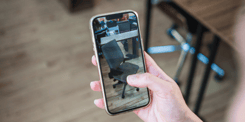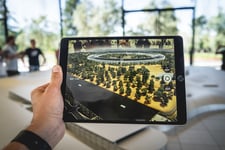Augmented reality (AR) is a technology that lets you view digital objects overlaid onto the real world, enhancing our understanding of their design and how they fit in with our surroundings. By combining real-world elements with computer-generated content, AR can provide immersive and interactive experiences.
In the realm of architecture and furniture design, AR has emerged as a powerful tool for visualizing and presenting projects. By allowing users to see how designs would look in real-world settings, AR can bridge the gap between imagination and reality. This is particularly valuable for:
- Client Presentations: AR can bring designs to life, making them more engaging and easier to understand for clients who may not have a technical background.
- Design Collaboration: Architects and designers can collaborate more effectively by visualizing their work together in a shared AR space.
- Error Reduction: AR can help identify potential problems or conflicts early in the design process, reducing the need for costly revisions.
- Enhanced Customer Experience: AR can provide customers with a more interactive and personalized shopping experience, helping them visualize products in their own homes.
In the following sections, we'll explore how to create AR objects for architectural and furniture projects using Yulio VR and how you can view them when created!
Creating AR Hotspots
Yulio’s AR Hotspot feature allows you to bring elements to life and see how your digital products can interact with the physical world using Augmented Reality. With Yulio’s AR Hotspot feature, you can insert an AR Hotspot into your VR experience to see the product in full 360 and take it one step further by using your phone or tablet to actually see the product in your physical space. AR hotspots allow you to show how your products or designs will interact with your client's real-world space, directly from your VR experiences.

Begin by selecting the VR project you would like to edit. From the edit project page, select the AR Models tab. Next upload your AR model into the upload box. AR models must meet our upload requirements; GLB format, up to 75 MB and must have at least one camera defined.
Once your model has finished processing, open the Hotspot Editor to create your AR Hotspot. In the Hotspot Editor, select the AR Annotations tab. Here you will see the AR model you just uploaded. From there, click on your AR Model from the left panel and drag and drop it into your scene to create your AR Hotspot. And that’s it! Your AR Hotspot is now ready to go. View the project in 360 to interact with your AR Hotspot.

How to View an AR Hotspot
To view and interact with an AR Hotspot, you will need a smartphone or tablet. Begin by clicking on the AR hotspot icon and the AR model will center on screen. Click and drag your cursor across the model to rotate the model or reset your view back to the original position by selecting the reset icon in the bottom right-hand corner. Or to go back to your VR experience, select the arrow in the top left-hand corner.

To view in AR and interact with the model in your physical space, select the View in AR button in the bottom right-hand corner. Next you will need your smartphone or tablet to scan the QR code. On most smartphones, you can simply open your camera app and point it at the QA code to scan. When you scan the QR code on your smartphone, it will prompt you to open the AR Model link at vr.yulio.com

When you open the link, the AR model will appear in your internet browser on your device. To view in AR and insert the digital model into your physical space, select the View in AR button. From there, your object will appear in your real-world environment using augmented reality. You can manipulate the object by moving it around and resizing it to fit your space.

Step into the Future with AR
As AR technology continues to change, its uses in architecture and furniture design will undoubtedly continue to grow. By leveraging the power of AR, designers and manufacturers can create more immersive, engaging, and effective presentations for clients and other interested parties
Whether you're an architect, interior designer, or furniture manufacturer, incorporating AR into your workflow can offer several benefits. From improved client communication to enhanced design collaboration, AR is in a prime position to revolutionize the way we visualize and experience the built environment.



.png?width=245&height=150&name=Meta%20Quest%20Pro%20Blog%20image%20(1).png)

%20(1)-1.jpg?width=245&height=150&name=BUSINESS%20READY%20VR%2061%20(3)%20(1)-1.jpg)
